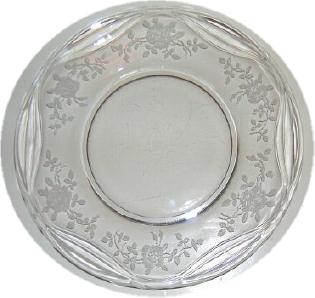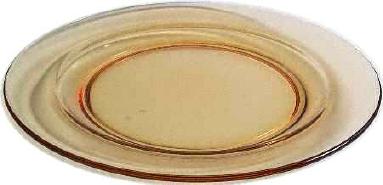National Depression Glass Association
Preserving America's Glass Manufacturing Heritage
Fostoria Elegant Glass: Coronet and Pioneer
by Kathy Eickholt
Fostoria plain glass patterns are so elegant and are well-suited to today's decorating themes of simplicity and shape. With the undecorated blanks the beauty of the glass itself takes center stage.
Coronet
Coronet is a personal favorite with its round shapes and graceful wavy lines. Fostoria used Coronet, line number 2560, with several etchings, notably Willowmere (as shown in the photo, below left). Coronet was produced primarily from 1938 to 1943 although there were some pieces available until 1960. It's one of the blanks so pretty by itself it doesn't really gain anything by being etched.
 Coronet is easy to identify. Look for three wavy lines, like
ripples, that are near the rim. The other pattern that has wavy lines
is number 2650 Horizon, but you are unlikely to mistake the two since
Horizon is less common, had more severe shapes and came in spruce green
and cinnamon brown. Coronet handles are especially nice, with curled up
ridges that look like ram's horns. The handles are a little Colony
handles, but Colony has an all-over swirl design.
Coronet is easy to identify. Look for three wavy lines, like
ripples, that are near the rim. The other pattern that has wavy lines
is number 2650 Horizon, but you are unlikely to mistake the two since
Horizon is less common, had more severe shapes and came in spruce green
and cinnamon brown. Coronet handles are especially nice, with curled up
ridges that look like ram's horns. The handles are a little Colony
handles, but Colony has an all-over swirl design.
Oddly enough, Coronet is one of the less common designs in plain crystal. You may find relish trays, plates, serving pieces, console bowls, ice buckets and the usual table setting pieces such as cups and saucers. Also watch out for the relish, ice bucket, mayo, creamer, sugar, tidbit and serving plate. We have had other pieces but apparently others besides us enjoy this pattern!
Fostoria made Coronet in crystal only. This was after the period when colored glass was big, which ended roughly in the mid 1930s. Although Fostoria made colored glass every year, crystal was the big seller after about 1940 and the Coronet pattern reflects this preference.
Coronet doesn't appear particularly susceptible to damage; the curved shapes and rather solid handles are not prone to chipping or cracks. You will want to check for scratches and wear. All these clear patterns, that do not have etches or cuttings that help hide wear, are most beautiful without wear. It's hard to find glass 50 years old that doesn't have some evidence of age, but do be wary of glass that has noticeable scratches or center wear. If you buy online and the seller does not mention wear then be sure to ask about it and don't rely on words like "mint." Also look for clarity. Pieces like this that don't have decorations to distract they eye are beautiful because the glass is crystal clear and capture the light. You will want glass that is as clear as possible.
As with almost all of Fostoria's elegant glass, Coronet pieces have ground base rims and the seams are faint and smooth. Fostoria fire polished their glass which reduced the prevalence of the raised seam ridges so common in lesser quality depression glass. Coronet did not have full stemware as a separate pattern. It goes well with most Fostoria patterns and you may want to consider using etched stemware, such as Willowmere, that has curved lines and graceful designs that would complement the Coronet shapes.
Pioneer
Pioneer was one of the earliest designs to be offered in a full dinnerware service. Previously glass patterns were offered primarily in serving or decorative lines, with some limited tableware. Fostoria made Pioneer elegant glass as line number 2350 from 1926 to 1960 and in several colors. You'll find crystal of course, as well as particularly luscious amber, green, blue, some pink, azure blue and some pieces in ebony, ruby, burgundy and empire green. The amber is a personal favorite as it is a rich shade of gold with warm reddish tones and not a trace of olive or green. The green is also very nice; it is a true emerald green, no blue or yellow and medium toned. Any of these is lovely on its own and simply stunning with one of Fostoria's etchings.
 Pioneer shapes are simple and straightforward. The creamers and
sugars in my mind look like you would expect glass pieces to look. The
handles are gentle curves, not extremely wide or exaggerated and the
bases are either flat or slightly domed. The handles have a slight
groove on the outside center which helps identify pieces and the tops
curl into the glass leaving a small bead at the end. Shapes are round
and without curlicues or scallops. These clean lines make Pioneer
particularly suited for complicated etchings such as Vesper or
Versailles. If you find a piece of unetched glass that is round, fits
the Fostoria measurements and has clean style it may be Pioneer.
Pioneer shapes are simple and straightforward. The creamers and
sugars in my mind look like you would expect glass pieces to look. The
handles are gentle curves, not extremely wide or exaggerated and the
bases are either flat or slightly domed. The handles have a slight
groove on the outside center which helps identify pieces and the tops
curl into the glass leaving a small bead at the end. Shapes are round
and without curlicues or scallops. These clean lines make Pioneer
particularly suited for complicated etchings such as Vesper or
Versailles. If you find a piece of unetched glass that is round, fits
the Fostoria measurements and has clean style it may be Pioneer.
Pioneer is not particularly prone to damage. Plates and bowls can get scratched from stacking and it can be easier to see wear on a plain design than on a busier one. Be sure to check for nicks and cracks as with any glass, but the main point to be aware of is the surface wear. Often the ground base rims get scratches and even pinhole nicks; these are not usually considered problems unless they are so significant to be noticeable from the top.
Pieces of Pioneer that are especially nice include the rolled edge console bowls and creamers and sugars. The rolled edge console bowl is large and looks impressive on a table, either alone or filled with flowers. Console bowls were meant to decorate a table set against the wall or to be used as centerpieces and were fairly large with the rims rolled right over almost far enough to touch the table top. This was a spectacular way to show off the etch. Plain bowls are also really special since the glass is beautiful and the shape so very appealing. Pioneer console bowls came in at least two sizes, one that is about 11 inches wide and a larger one that was 13 to 14 inches.
Fostoria made beautiful glass for many years and these are only two of their extensive lines of tableware glass.
Webmaster's NOTE: The NDGA wishes to thank the author for permission to use this article. Kathy is a dealer from Midland, Michigan. Her web site is Cat Lady's Glass.